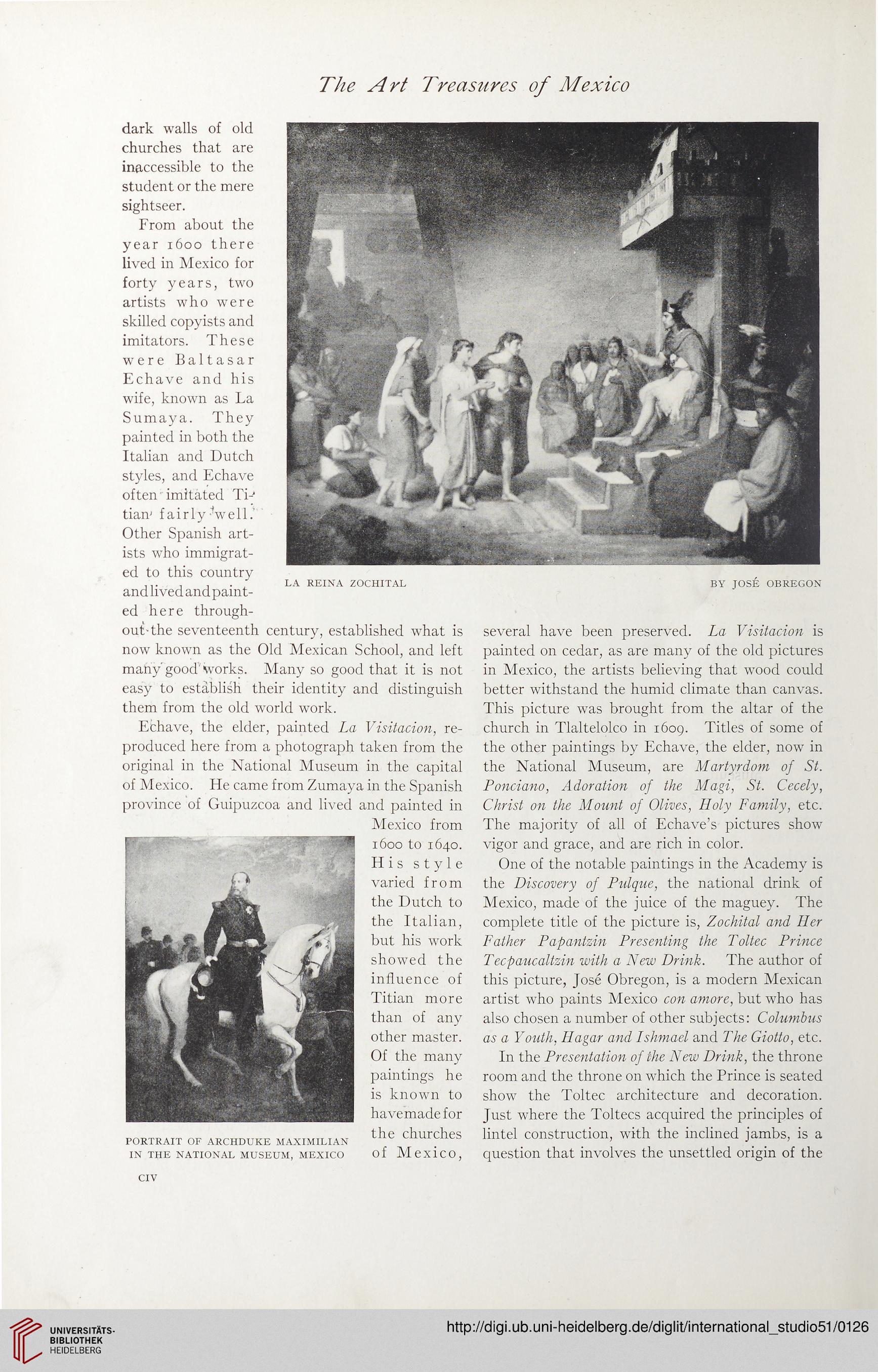The Art Treasures of Mexico
dark walls of old
churches that are
inaccessible to the
student or the mere
sightseer.
From about the
year 1600 there
lived in Mexico for
forty years, two
artists who were
skilled copyists and
imitators. These
were Baltasar
Echave and his
wife, known as La
Sumaya. They
painted in both the
Italian and Dutch
styles, and Echave
often imitated Ti-J
tianJ fairly'well.'
Other Spanish art¬
ists who immigrat¬
ed to this country
... , , . ; LA REINA ZOCHITAL
and lived and paint¬
ed here through¬
out-the seventeenth century, established what is
now known as the Old Mexican School, and left
many'good'works. Many so good that it is not
easy to establish their identity and distinguish
BY JOSE OBREGON
several have been preserved. La Visitacion is
painted on cedar, as are many of the old pictures
in Mexico, the artists believing that wood could
better withstand the humid climate than canvas.
them from the old world work.
Echave, the elder, painted La Visitacion, re-
produced here from a photograph taken from the
original in the National Museum in the capital
of Mexico. He came from Zumaya in the Spanish
province of Guipuzcoa and lived and painted in
Mexico from
PORTRAIT OF ARCHDUKE MAXIMILIAN
IN THE NATIONAL MUSEUM, MEXICO
1600 to 1640.
His style
varied from
the Dutch to
the Italian,
but his work
showed the
influence of
Titian more
than of any
other master.
Of the many
paintings he
is known to
havemade for
the churches
of Mexico,
This picture was brought from the altar of the
church in Tlaltelolco in 1609. Titles of some of
the other paintings by Echave, the elder, now in
the National Museum, are Martyrdom of St.
Ponciano, Adoration of the Magi, St. Cecely,
Christ on the Mount of Olives, Holy Family, etc.
The majority of all of Echave’s pictures show
vigor and grace, and are rich in color.
One of the notable paintings in the Academy is
the Discovery of Pulque, the national drink of
Mexico, made of the juice of the maguey. The
complete title of the picture is, Zochital and Her
Father Papantzin Presenting the Toltec Prince
Tecpaucaltzin with a New Drink. The author of
this picture, Jose Obregon, is a modern Mexican
artist who paints Mexico con amore, but who has
also chosen a number of other subjects: Columbus
as a Youth, Hagar and Ishmael and The Giotto, etc.
In the Presentation of the New Drink, the throne
room and the throne on which the Prince is seated
show the Toltec architecture and decoration.
Just where the Toltecs acquired the principles of
lintel construction, with the inclined jambs, is a
question that involves the unsettled origin of the
civ
dark walls of old
churches that are
inaccessible to the
student or the mere
sightseer.
From about the
year 1600 there
lived in Mexico for
forty years, two
artists who were
skilled copyists and
imitators. These
were Baltasar
Echave and his
wife, known as La
Sumaya. They
painted in both the
Italian and Dutch
styles, and Echave
often imitated Ti-J
tianJ fairly'well.'
Other Spanish art¬
ists who immigrat¬
ed to this country
... , , . ; LA REINA ZOCHITAL
and lived and paint¬
ed here through¬
out-the seventeenth century, established what is
now known as the Old Mexican School, and left
many'good'works. Many so good that it is not
easy to establish their identity and distinguish
BY JOSE OBREGON
several have been preserved. La Visitacion is
painted on cedar, as are many of the old pictures
in Mexico, the artists believing that wood could
better withstand the humid climate than canvas.
them from the old world work.
Echave, the elder, painted La Visitacion, re-
produced here from a photograph taken from the
original in the National Museum in the capital
of Mexico. He came from Zumaya in the Spanish
province of Guipuzcoa and lived and painted in
Mexico from
PORTRAIT OF ARCHDUKE MAXIMILIAN
IN THE NATIONAL MUSEUM, MEXICO
1600 to 1640.
His style
varied from
the Dutch to
the Italian,
but his work
showed the
influence of
Titian more
than of any
other master.
Of the many
paintings he
is known to
havemade for
the churches
of Mexico,
This picture was brought from the altar of the
church in Tlaltelolco in 1609. Titles of some of
the other paintings by Echave, the elder, now in
the National Museum, are Martyrdom of St.
Ponciano, Adoration of the Magi, St. Cecely,
Christ on the Mount of Olives, Holy Family, etc.
The majority of all of Echave’s pictures show
vigor and grace, and are rich in color.
One of the notable paintings in the Academy is
the Discovery of Pulque, the national drink of
Mexico, made of the juice of the maguey. The
complete title of the picture is, Zochital and Her
Father Papantzin Presenting the Toltec Prince
Tecpaucaltzin with a New Drink. The author of
this picture, Jose Obregon, is a modern Mexican
artist who paints Mexico con amore, but who has
also chosen a number of other subjects: Columbus
as a Youth, Hagar and Ishmael and The Giotto, etc.
In the Presentation of the New Drink, the throne
room and the throne on which the Prince is seated
show the Toltec architecture and decoration.
Just where the Toltecs acquired the principles of
lintel construction, with the inclined jambs, is a
question that involves the unsettled origin of the
civ





